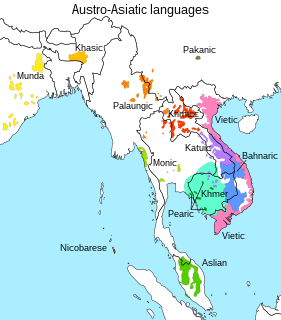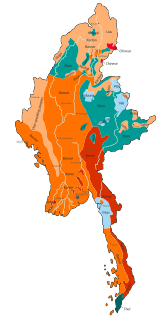
The Austroasiatic languages, also known as Mon–Khmer, are a large language family of Mainland Southeast Asia, also scattered throughout India, Bangladesh, Nepal and the southern border of China, with around 117 million speakers. The name Austroasiatic comes from a combination of the Latin words for "South" and "Asia", hence "South Asia". Of these languages, only Vietnamese, Khmer, and Mon have a long-established recorded history, and only Vietnamese and Khmer have official status as modern national languages. In Myanmar, the Wa language is the de facto official language of Wa State. Santali is recognized as a regional language of India. The rest of the languages are spoken by minority groups and have no official status.
The Mon language is an Austroasiatic language spoken by the Mon people, who live in Myanmar. Mon, like the related Khmer language, but unlike most languages in mainland Southeast Asia, is not tonal. In recent years, usage of Mon has declined rapidly, especially among the younger generation. Many ethnic Mon are monolingual in Burmese, and the language is classified as "vulnerable" by UNESCO. The current number of speakers is approximately 800,000 in 2007. In Myanmar, the majority of speakers live in Mon State, followed by Tanintharyi Region and Kayin State.

The Shan are a Tai ethnic group of Southeast Asia. The Shan live primarily in the Shan State of Burma (Myanmar), but also inhabit parts of Mandalay Region, Kachin State, and Kayin State, and in adjacent regions of China, Laos, Assam and Thailand. Though no reliable census has been taken in Burma since 1935, the Shan are estimated to number 4–6 million, with CIA Factbook giving an estimate of five million spread throughout Myanmar.

The Hmong–Mien languages are a highly tonal language family of southern China and northern Southeast Asia. They are spoken in mountainous areas of southern China, including Guizhou, Hunan, Yunnan, Sichuan, Guangxi, and Hubei provinces, where its speakers have been relegated to being "hill people", whereas the neighboring Han Chinese have settled the more fertile river valleys.
The Shan language, Shan spoken: ၵႂၢမ်းတႆး, pronounced [kwáːm táj](listen)), or ၽႃႇသႃႇတႆး, pronounced [pʰàːsʰàː táj]; Burmese: ရှမ်းဘာသာ, pronounced [ʃáɴ bàðà]; Thai: ภาษาไทใหญ่, pronounced [pʰāː.sǎː.tʰāj.jàj]) is the native language of the Shan people and is mostly spoken in Shan State, Burma. It is also spoken in pockets of Kachin State in Burma, in northern Thailand, and decreasingly in Assam. Shan is a member of the Tai–Kadai language family, and is related to Thai. It has five tones, which do not correspond exactly to Thai tones, plus a "sixth tone" used for emphasis. It is called Tai Yai, or Tai Long in the Tai languages.

The nearly thirty Palaungic or Palaung–Wa languages form a branch of the Austroasiatic languages.

The largest of the ethnic groups in Cambodia are the Khmer, who comprise approximately 90% of the total population and primarily inhabit the lowland Mekong subregion and the central plains. The Khmer historically have lived near the lower Mekong River in a contiguous arc that runs from the southern Khorat Plateau where modern-day Thailand, Laos and Cambodia meet in the northeast, stretching southwest through the lands surrounding Tonle Sap lake to the Cardamom Mountains, then continues back southeast to the mouth of the Mekong River in southeastern Vietnam.

There are approximately a hundred languages spoken in Myanmar. Burmese, spoken by two thirds of the population, is the official language.
The Gong language is an endangered Tibeto-Burman language of Western Thailand, spoken in isolated pockets in Uthai Thani and Suphanburi provinces.

An ethnolinguistic map of Thailand. Thailand, and its neighbor Laos, are dominated by languages of the Southwestern Tai family. Karen languages are spoken along the border with Burma, Khmer is spoken near Cambodia and Malay in the south near Malaysia. The following table comprises all 62 ethnic groups recognised by the Royal Thai Government in the 2011 Country Report to the UN Committee responsible for the International Convention for the Elimination of All Forms of Racial Discrimination, available from the Department of Rights and Liberties Promotion of the Thai Ministry of Justice.
Wa (Va) is the language of the Wa people of Burma and China. There are three distinct varieties, sometimes considered separate languages; their names in Ethnologue are Parauk, the majority and standard form; Vo, and Awa, though all may be called Wa, Awa, Va, Vo. David Bradley (1994) estimates there are total of 820,000 Wa speakers.

Palaung, or in Chinese De'ang, is a Mon–Khmer dialect cluster spoken by over half a million people in Burma and neighboring countries. The Palaung people are divided into Palé, Rumai, and Shwe, and each of these has their own language. The Riang languages are reported to be unintelligible or only understood with great difficulty by native speakers of the other Palaung languages.
Va is a pair of Angkuic languages spoken in Mojiang Hani Autonomous County, Yunnan, China. Although the Va autonym is, the language is not Wa, and neither does it belong to the Waic language subgroup. Rather, Va constitutes a separate subdivision within the Angkuic languages.
Samre, is a nearly extinct Pearic language of Thailand and, formerly, Cambodia. The language is evidently extinct in Cambodia, but a 1998 survey found 20–30 speakers in Nonsi Subdistrict, Bo Rai District, Trat Province, Thailand and estimated the total number of people able to speak the language to be 200.
Sa'och is an endangered, nearly extinct Pearic language of Cambodia and Thailand spoken only occasionally by a decreasing number of older adults. There are two dialects, one spoken in Veal Renh Village, Prey Nob District, Sihanoukville Province, Cambodia and the other in Kanchanaburi Province, Thailand. "Sa'och" is the Khmer exonym for the people and the language. The Sa'och, however, consider this label, which means "scarlet fever" or "pimply" in Khmer, pejorative and use the autonym "Chung" to refer to themselves and their language.
Lamet is a Mon–Khmer language of Laos. There are also a hundred speakers in Lampang Province, Thailand, where it is known as Khamet. Lamet speakers call their language [χəmɛːt], or less commonly [kʰəmɛːt].
Mok, also known as Amok, Hsen-Hsum, and Muak, is a possibly extinct Angkuic language spoken in Shan State, Myanmar and in Lampang Province, Thailand. In Lampang Province, Thailand, 7 speakers were reported by Wurm & Hattori (1981).
Tai Loi, also known as Mong Lue, refers to various Palaungic languages spoken mainly in Burma, with a few hundred in Laos and some also in China. Hall (2017) reports that Tai Loi is a cover term meaning 'mountain Tai' in Shan, and refers to various Angkuic, Waic, and Western Palaungic languages rather than a single language or branch. The Shan exonym Tai Loi can refer to:

Mongyawng or Möngyawng was one of the Shan states. It was located in the narrow wedge of territory that projects eastwards from Kengtung State between China and Laos.










